Influence of Stator Core Seams on No-Load Performance of Module-Combined Stator Permanent Magnet Motor and Its Weakening Method
Abstract
1. Introduction
2. Magnetic Circuit Model with Consideration of Stator Core Seams
2.1. The Selection Principle of Seam Number
2.2. The Magnetic Circuit
- The flux in the left tooth and right tooth with the seam on the tooth are linearly proportional to the tooth width;
- The magnetic resistance of each segment was simplified to a rectangle in the calculation of the magnetic resistance;
- The magnetic permeability of the ferromagnetic material was set to be invariable, and the corresponding magnetic resistance was assumed to be invariable.
3. Influence of Seams on No-Load Performance
3.1. Influence of Different Seam Numbers and Seam Widths on No-Load Performance
- (1)
- The cogging torque amplitude was directly proportional to the seam number Nseam and the seam width bseam;
- (2)
- The effective value of no-load phase back electromotive force, the amplitude of the self-inductance, and mutual inductance were inversely proportional to the seam number Nseam and the seam width bseam;
- (3)
- The self-inductance LAA and mutual inductance LAC of A phase, which were closest to the seam, were the most affected by the seam number Nseam and the seam width bseam because the maximum mutual inductance variation extent (0.35 mH), which is influenced by the seam number Nseam and the seam width bseam, has little influence on motor performance; the mutual inductances that are influenced by the seam number Nseam and the seam width bseam are ignored in the following chapters.
3.2. The Relationship between Motor No-Load Performance and the Number of Parallel Branches in One Unit with Same Seam
3.3. The Relationship between Motor No-Load Performance and Slot–Pole Combination with Same Seam Parameters
- (1)
- More stator slots with the same rotor poles can weaken the no-load motor performance impact of seams: with the same 54-slot stator sheet parameter, the no-load motor performance impact of a seam with the 36-pole scheme was less than the 60-pole scheme; with the same 60-pole rotor parameter, the no-load motor performance impact of a seam with a 72-slot scheme was less than that of a 54-slot scheme;
- (2)
- When the number of stator teeth that continuously wind the same phase coil in one polar phase group was more than three, the seam on the side of the same phase coil tooth weakened the no-load motor performance impact of the seam. The no-load motor performance impact of the seam in Figure 8b was less than that in Figure 8c, where the seam is in the middle of the same phase coil tooth.
- (1)
- Reduce the number of the stator core seams and width of the stator core seams;
- (2)
- Reduce the number of parallel branches in one stator sub-module;
- (3)
- Adopt fewer poles and more slots;
- (4)
- When the number of stator teeth that continuously wind the same phase coil in one polar phase group is more than three, place the seam on the same side as the phase coil tooth.
4. Stator Sheet Structures That Can Weaken the Impact of Seams
4.1. No-Load Motor Performance Impact of Seams on Different Parts of Tooth
- (1)
- The no-load cogging torque was chiefly affected by a seam on the top of the tooth (compare Figure 10a,c);
- (2)
- The no-load back electromotive force and self-inductance were mainly affected by a seam on the top of the tooth (compare Figure 10a–c);
- (3)
- The no-load motor performance impact of a seam on the yoke was negligible (compare Figure 10b,c).
4.2. Proposed New Stator Sheet Structures
- (1)
- Compared with the narrow tooth and auxiliary seam on the top of the tooth scheme (Figure 12b,d), an auxiliary seam (Figure 12a,c) was better at weakening the no-load cogging torque and self-inductance impact of the seam but worse at weakening the no-load asymmetry factor of the back electromotive force impact of the seam;
- (2)
- Compared with one tooth of B and C phase with an auxiliary seam or narrow tooth (Figure 12c,d), each whole tooth with an auxiliary seam or narrow tooth (Figure 12a,b) weakened the no-load cogging torque and self-inductance impact of the seam better, but reduced the back electromotive force value more.
- (1)
- (2)
- Increasing the height of auxiliary seam hseam2 can weaken the no-load cogging torque, but increase the asymmetry factor of no-load back electromotive force and decrease the value of no-load back electromotive force;
- (3)
- When the seam width bseam is increased (Figure 16), the cogging torque decreased to a smaller degree, and the asymmetry factor decreased, while no-load self-inductance and phase electromotive force remained nearly constant. Both schemes decreased the effective value of the back electromotive force to a greater degree, especially the Figure 14b scheme.
5. Discussion
Author Contributions
Funding
Data Availability Statement
Conflicts of Interest
References
- Crider, J.M.; Sudhoff, S.D. An Inner Rotor Flux-Modulated Permanent Magnet Synchronous Machine for Low-Speed High-Torque Applications. IEEE Trans. Energy Convers. 2015, 30, 1247–1254. [Google Scholar] [CrossRef]
- Valavi, M.; Le Besnerais, J.; Nysvee, A. An Investigation of Zeroth- Order Radial Magnetic Forces in Low-Speed Surface-Mounted Permanent Magnet Machines. IEEE Trans. Magn. 2016, 52, 1–6. [Google Scholar] [CrossRef]
- Fan, Y.; Zhu, W.; Zhang, X.; Cheng, M.; Chau, K.T. Research on a Single Phase-Loss Fault-Tolerant Control Strategy for a New Flux-Modulated Permanent-Magnet Compact In-Wheel Motor. IEEE Trans. Energy Convers. 2016, 31, 658–666. [Google Scholar] [CrossRef]
- Li, G.-J.; Zhu, Z.-Q.; Foster, M.P.; Stone, D.A.; Zhan, H.-L. Modular Permanent Magnet Machines with Alternate Teeth Having Tooth Tips. IEEE Trans. Ind. Electron. 2015, 62, 6120–6130. [Google Scholar] [CrossRef]
- Wang, J.; Atallah, K.; Zhu, Z.Q.; Howe, D. Modular Three-Phase Permanent-Magnet Brushless Machines for In-Wheel Applications. IEEE Trans. Veh. Technol. 2008, 57, 2714–2720. [Google Scholar] [CrossRef]
- Zhu, Z.Q.; Thomas, A.S.; Chen, J.T.; Jewell, G.W. Cogging torque in flux-switching permanent magnet machines. IEEE Trans. Magn. 2009, 45, 4708–4711. [Google Scholar] [CrossRef]
- Zhu, Z.Q.; Chen, J.T.; Wu, L.J.; Howe, D. Influence of stator asymmetry on cogging torque of permanent magnet brushless machines. IEEE Trans. Magn. 2008, 44, 3851–3854. [Google Scholar] [CrossRef]
- Li, G.J.; Zhu, Z.Q. Analytical Modeling of Modular and Unequal Tooth Width Surface-Mounted Permanent Magnet Machines. IEEE Trans. Magn. 2015, 51, 8107709. [Google Scholar] [CrossRef]
- Gan, B.; Zhang, B.; Li, Q.; Guihong, F.; Li, G. Research on Operation of Low-Speed and High-Torque Module Combined Stator Permanent Magnetic Fault-Tolerant Motor With Unequal Span Winding. IEEE Access 2020, 8, 166824–166838. [Google Scholar] [CrossRef]
- Xu, Y.; Zhang, B.; Feng, G. Analysis of Unwinding Stator Module Combined Permanent Magnet Synchronous Machine. IEEE Access 2020, 8, 191901–191909. [Google Scholar] [CrossRef]
- Zhang, B.; Gan, B.; Li, Q. Analysis of a Fault-Tolerant Module-Combined Stator Permanent Magnet Synchronous Machine. IEEE Access 2020, 8, 70438–70452. [Google Scholar] [CrossRef]
- Liu, Y.; Zhang, B.; Zong, M.; Feng, G.; Gan, B. Magnetic Field Prediction of Module-Combined Stator Permanent Magnet Synchronous Motor Based on a Nonlinear Hybrid Analytical Model. IEEE Access 2021, 9, 122486–122494. [Google Scholar] [CrossRef]
- Li, G.J.; Ren, B.; Zhu, Z.Q.; Li, Y.X.; Ma, J. Cogging Torque Mitigation of Modular Permanent Magnet Machines. IEEE Trans. Magn. 2016, 52, 8100210. [Google Scholar] [CrossRef]
- Li, G.J.; Ren, B.; Zhu, Z.Q. Cogging torque and torque ripple reduction of modular permanent magnet machines. In Proceedings of the 2016 XXII International Conference on Electrical Machines (ICEM), Lausanne, Switzerland, 4–7 September 2016; pp. 193–199. [Google Scholar] [CrossRef]
- Li, G.J.; Zhu, Z.Q.; Chu, W.Q.; Foster, M.P.; Stone, D.A. Influence of Flux Gaps on Electromagnetic Performance of Novel Modular PM Machines. IEEE Trans. Energy Convers. 2014, 29, 716–726. [Google Scholar] [CrossRef]
- Laldin, O.; Sudhoff, S.D.; Pekarek, S. Modified Carter’s Coefficient. IEEE Trans. Energy Convers. 2015, 30, 1133–1134. [Google Scholar] [CrossRef]
- Yin, H.; Zhang, H.; Hua, W.; Su, P. Improved Open-Circuit Airgap Field Model for FSCW-STPM Machines Considering PM-MMF Fluctuation. IEEE Trans. Ind. Electron. 2022, 69, 5547–5556. [Google Scholar] [CrossRef]
- Krause, P.; Wasynczuk, O.; Sudhoff, S.D.; Pekarek, S. Appendix B: Carter’s Coefficient. In Analysis of Electric Machinery and Drive Systems; Wiley-IEEE Press: New York, NY, USA, 2013; pp. 626–628. [Google Scholar] [CrossRef]
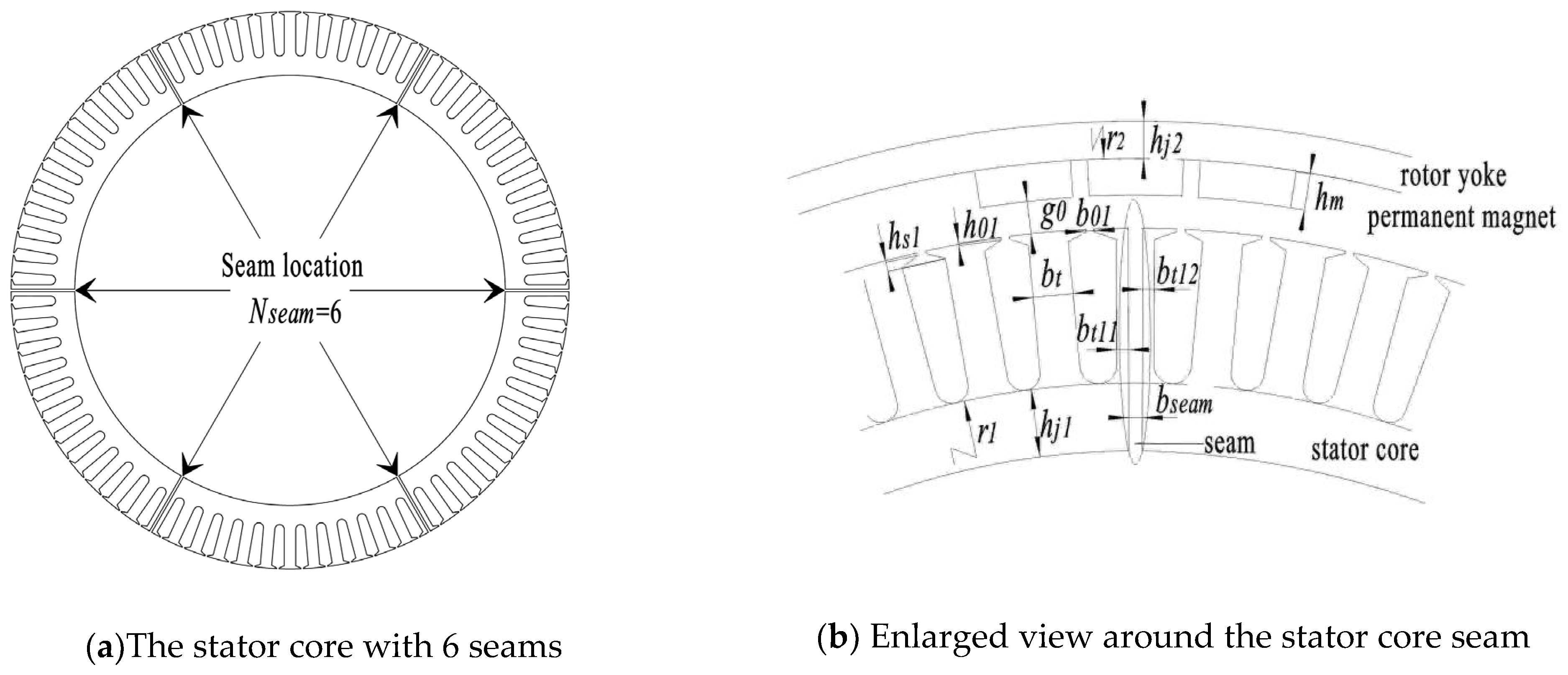
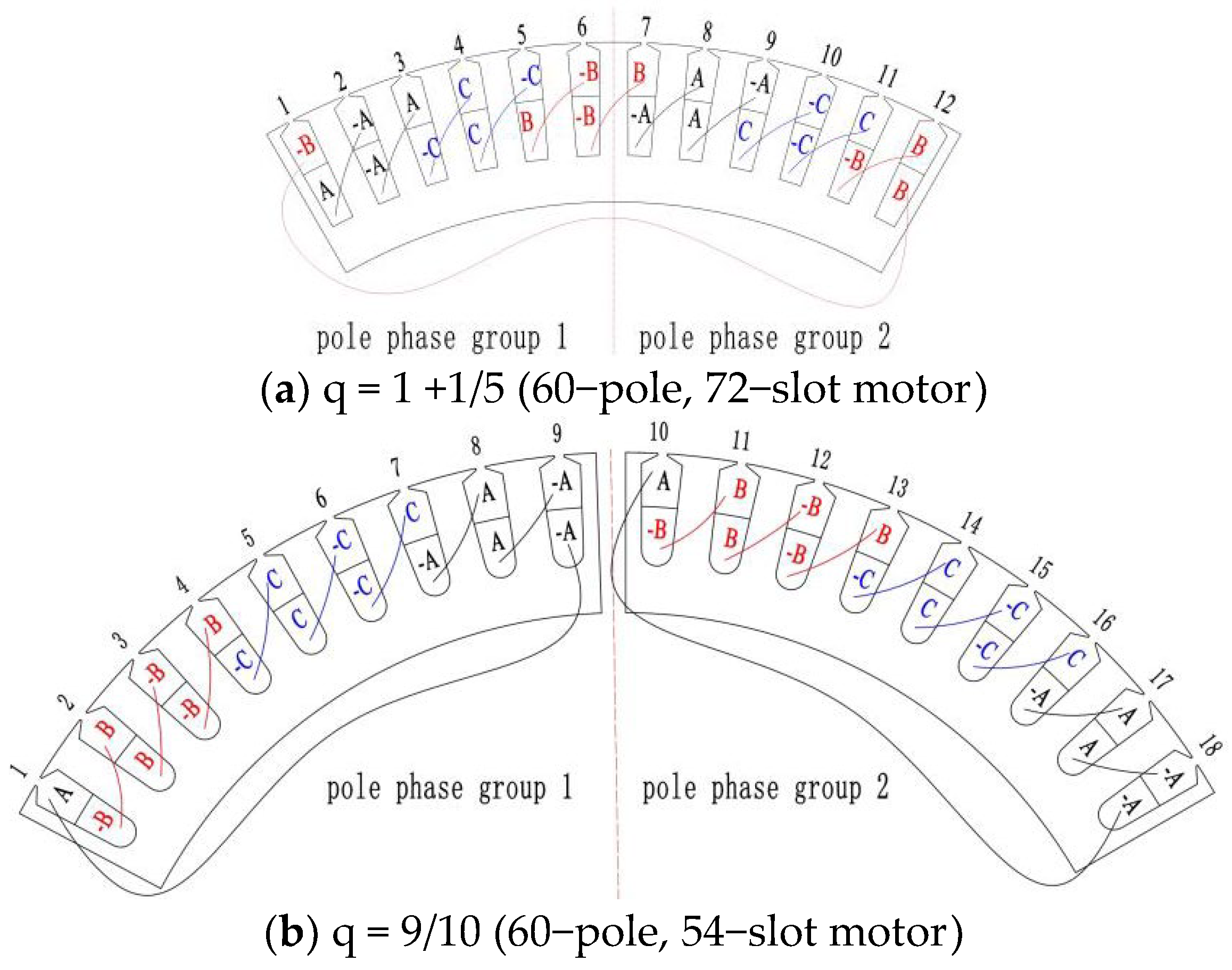


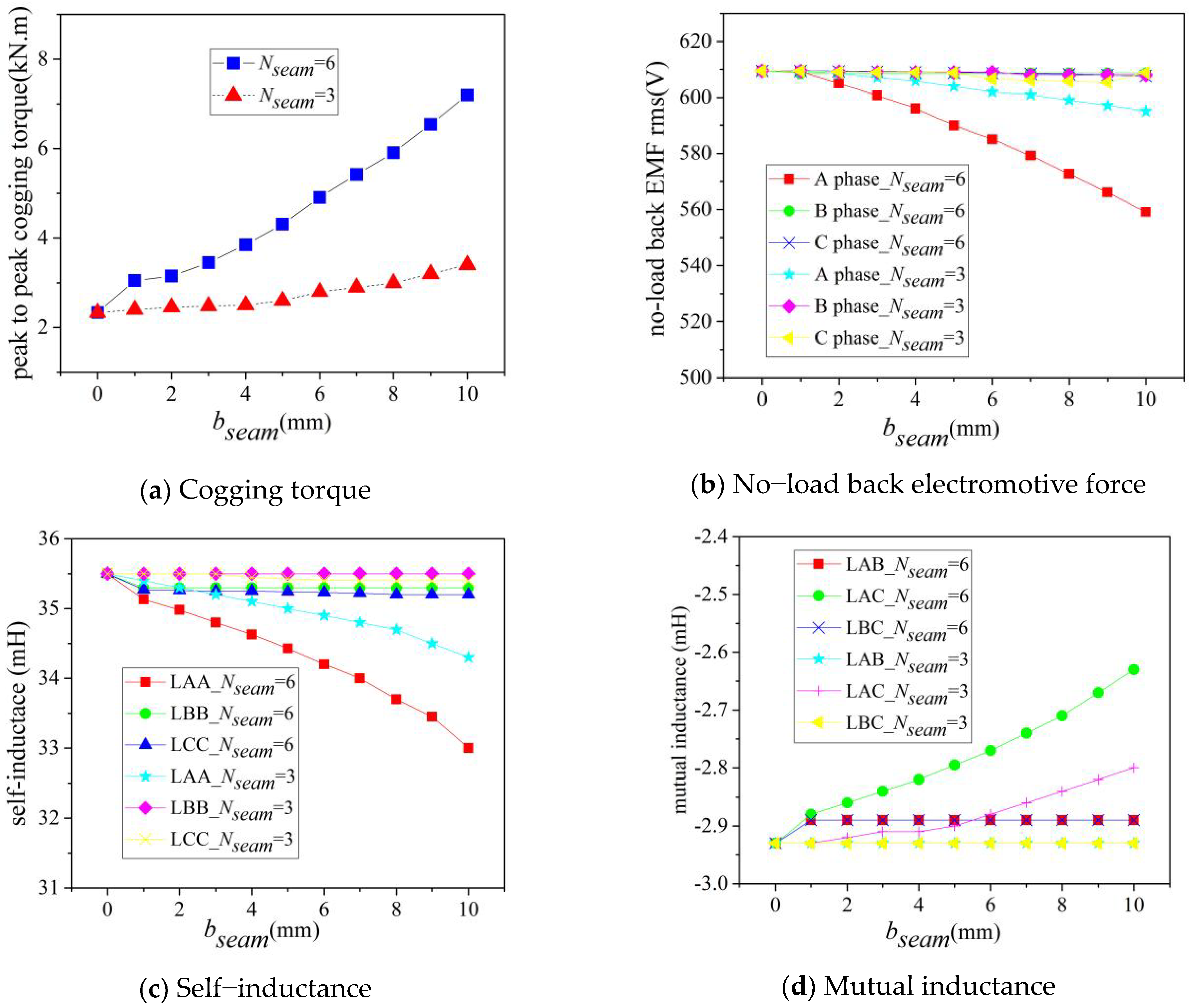

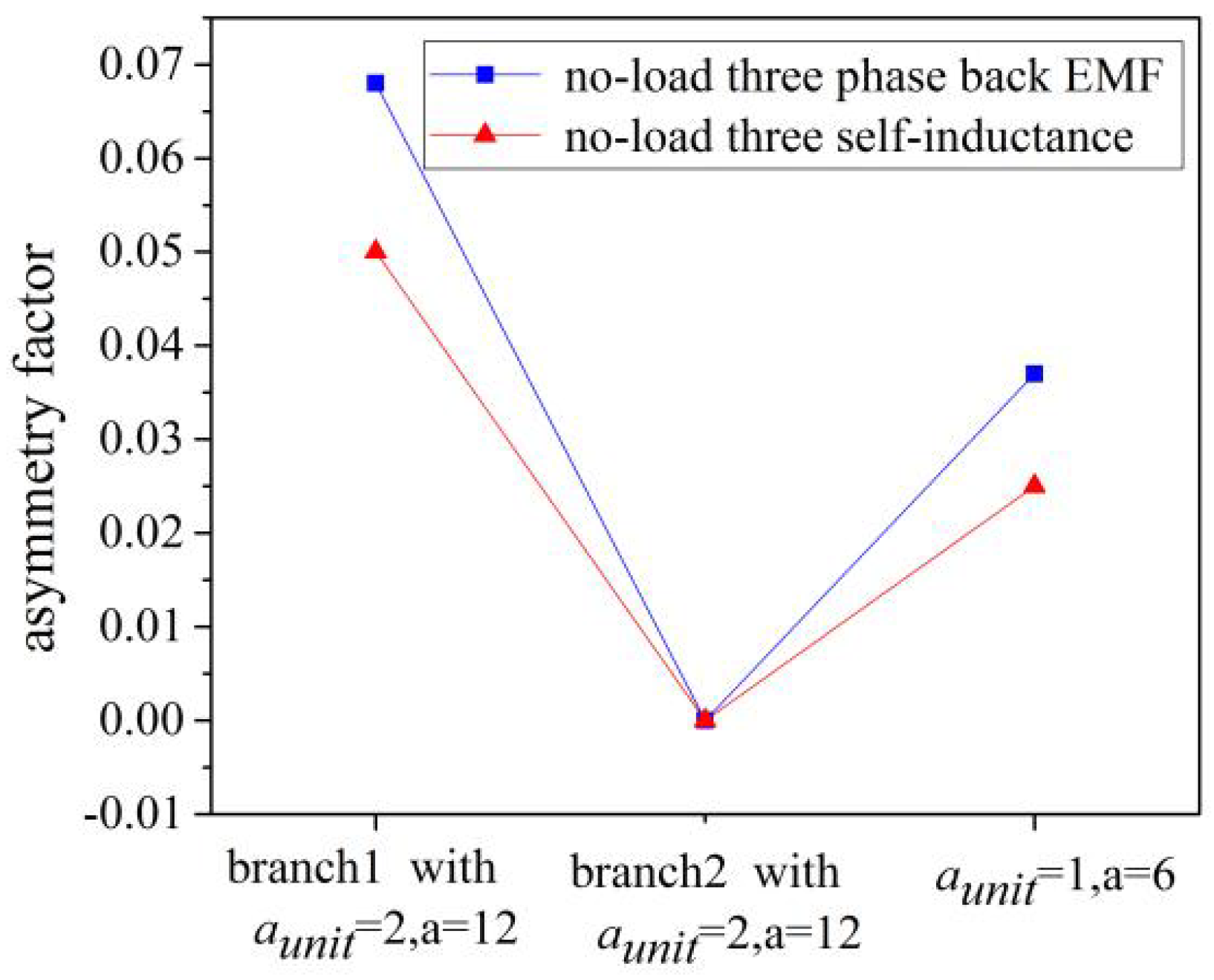
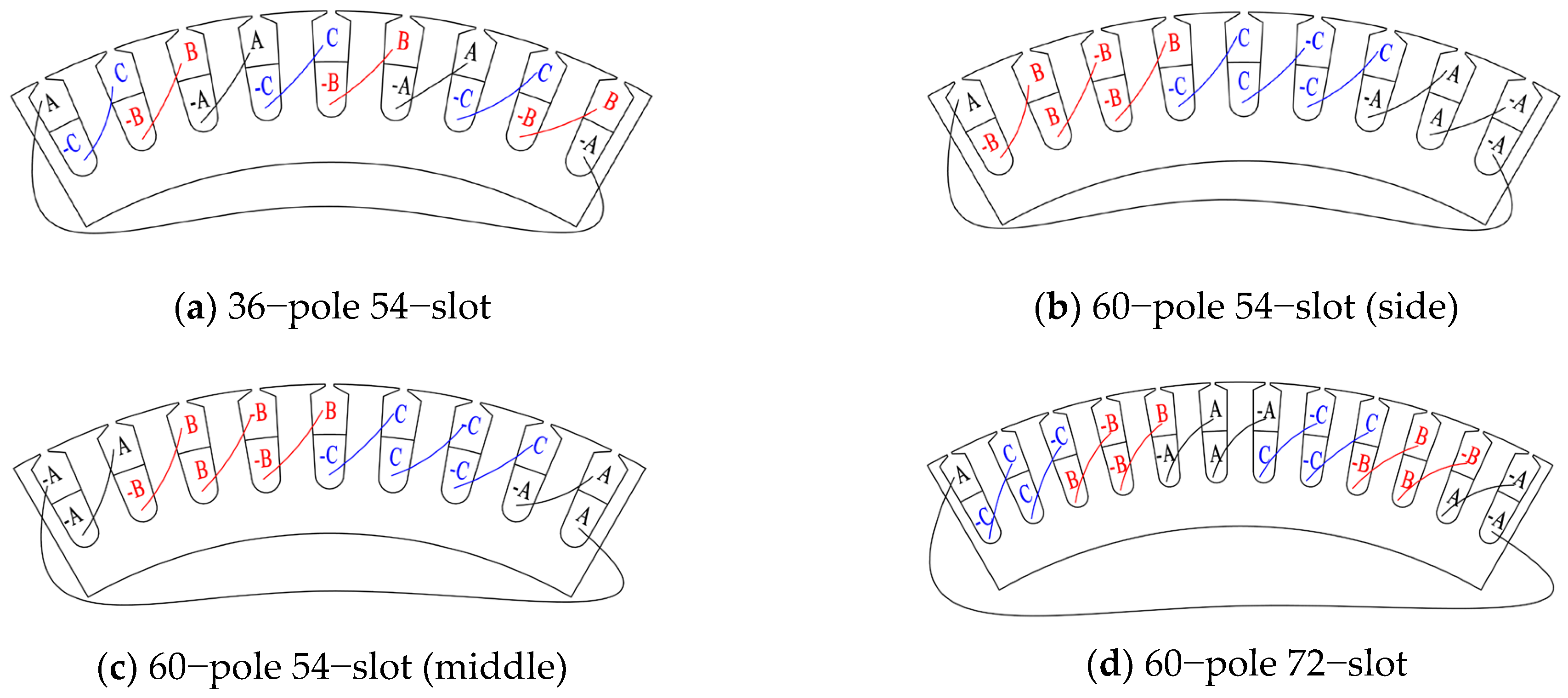
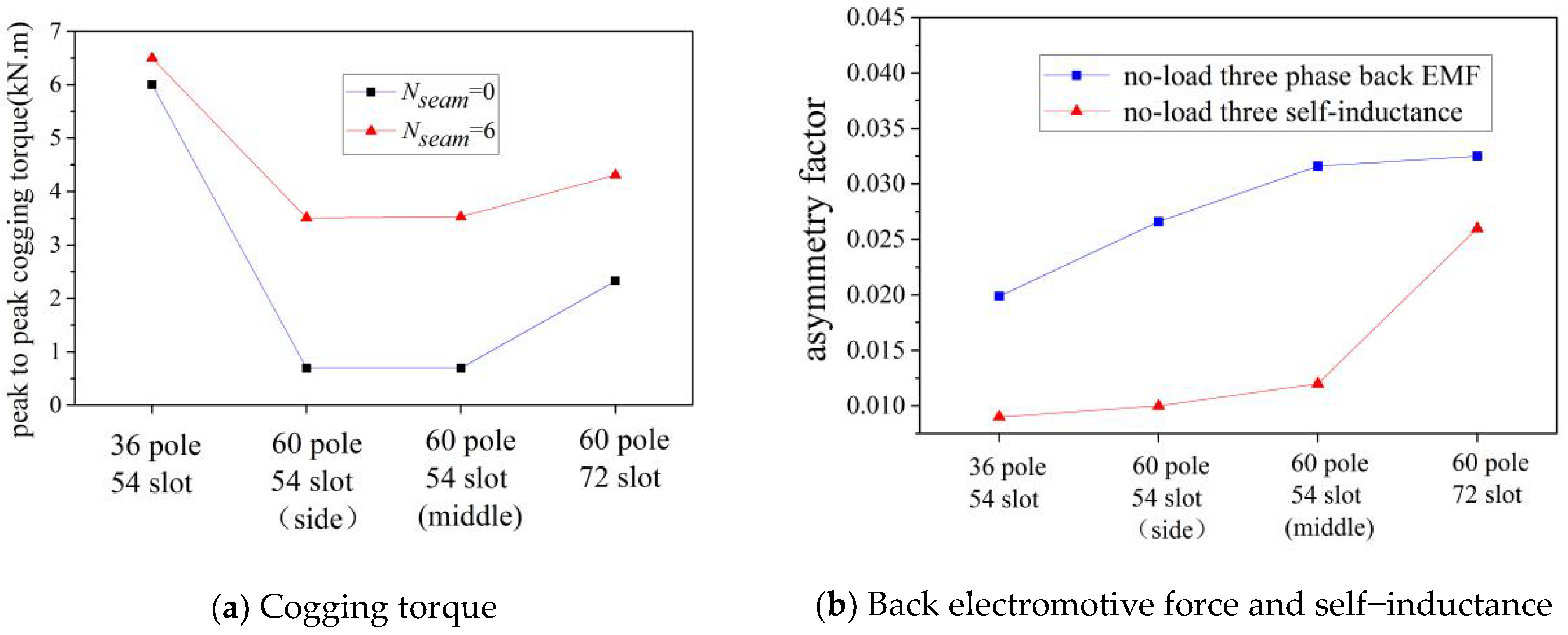


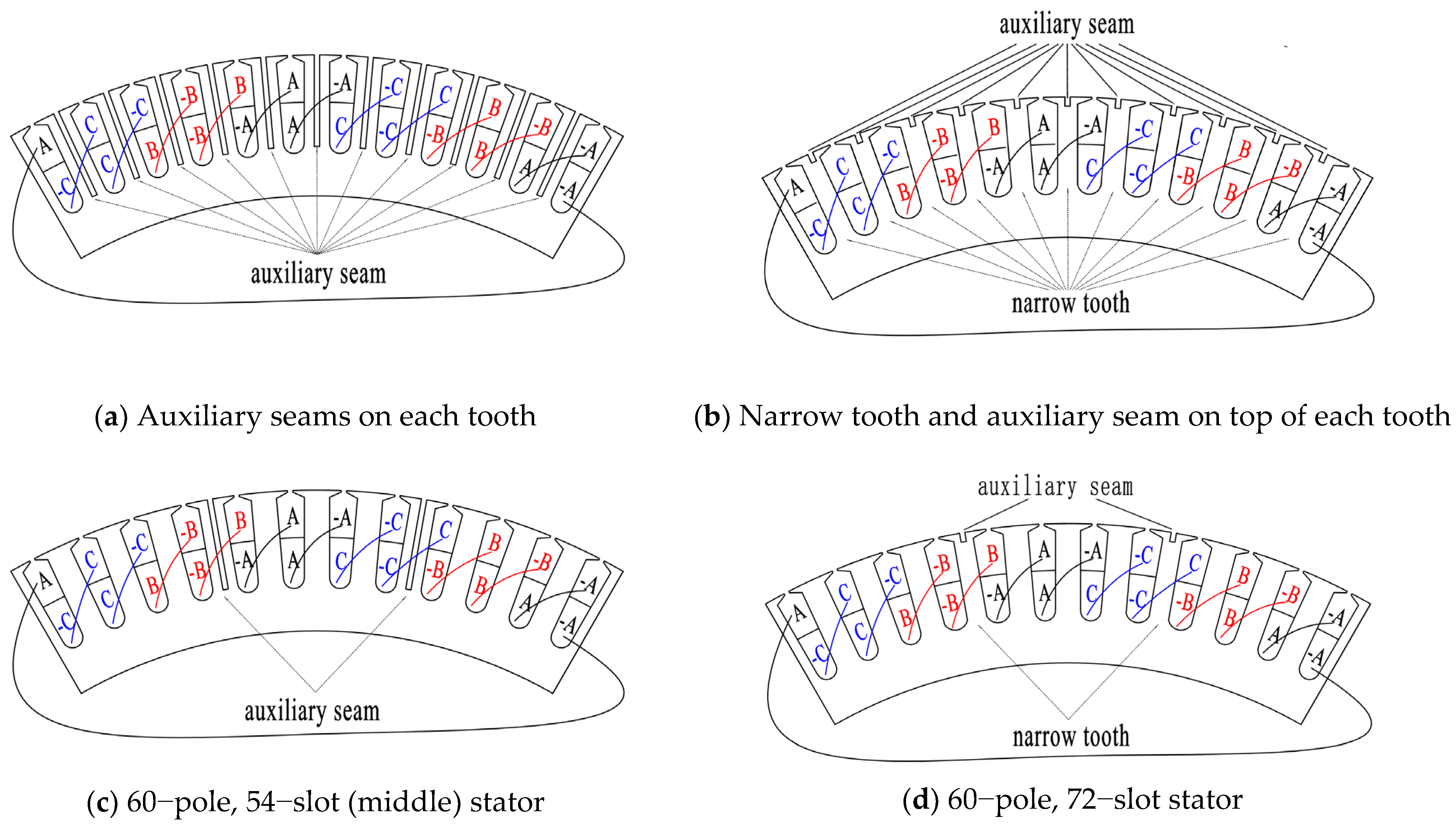
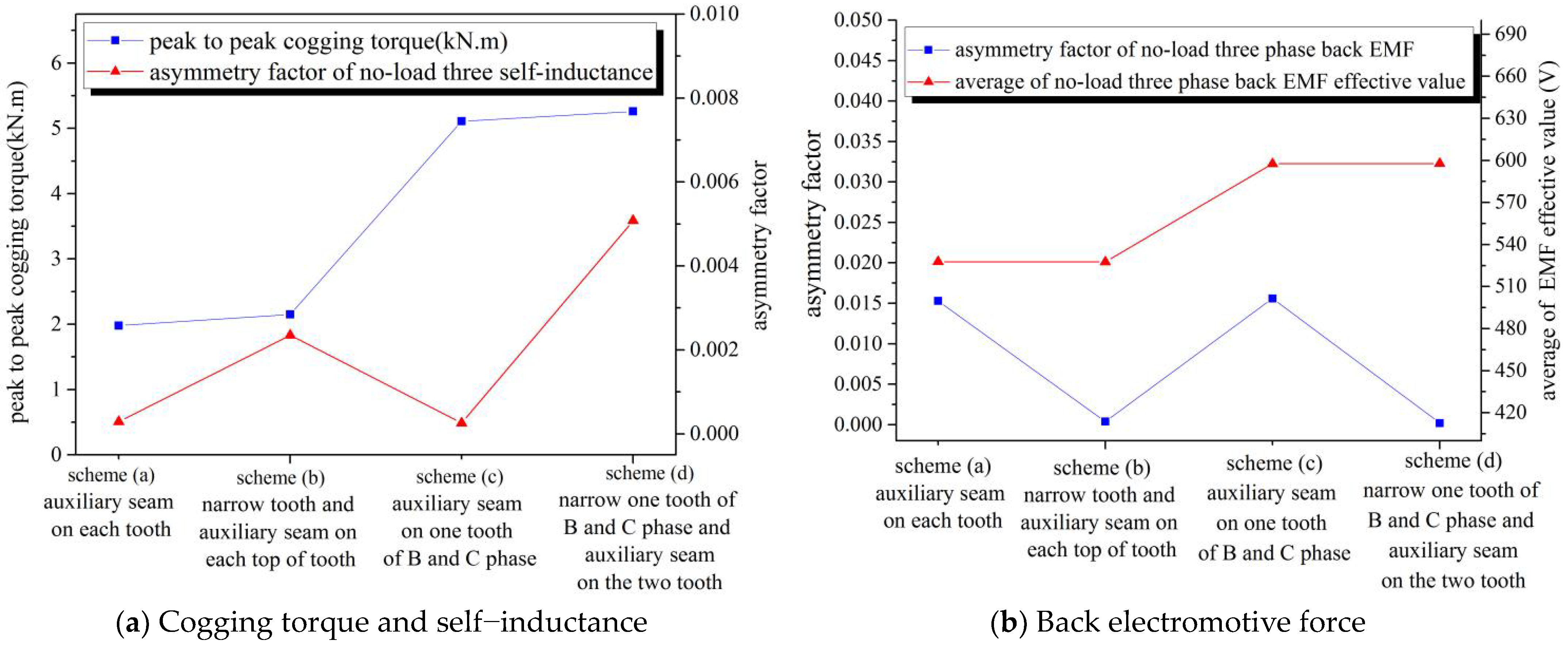
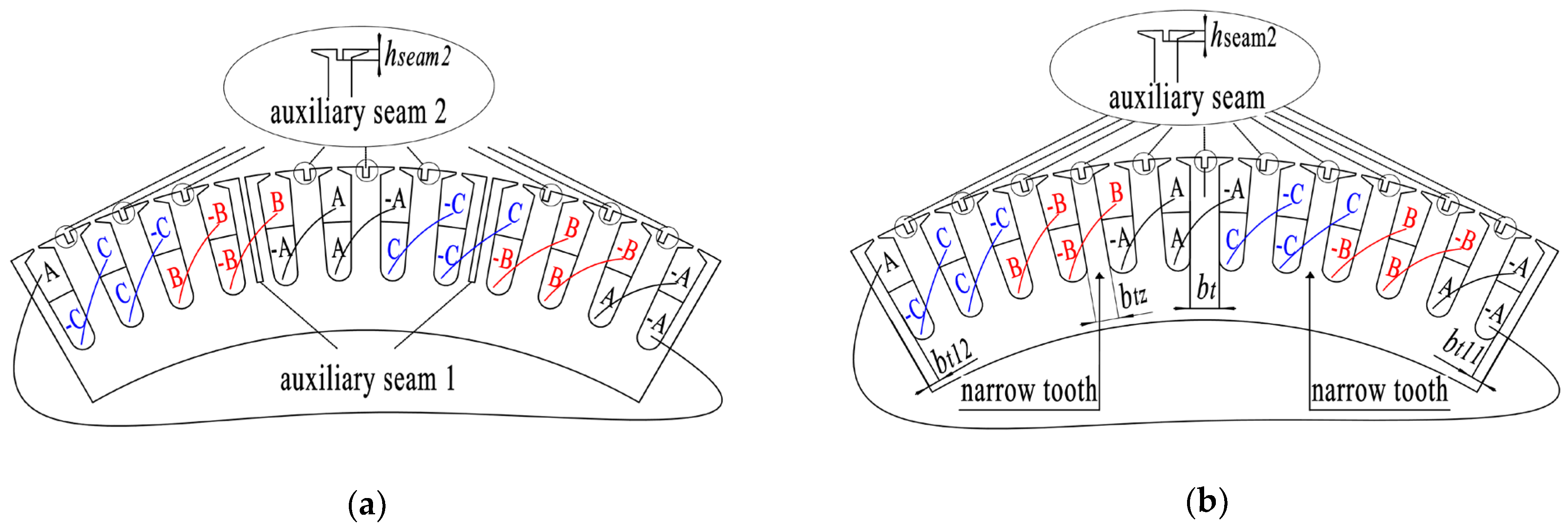
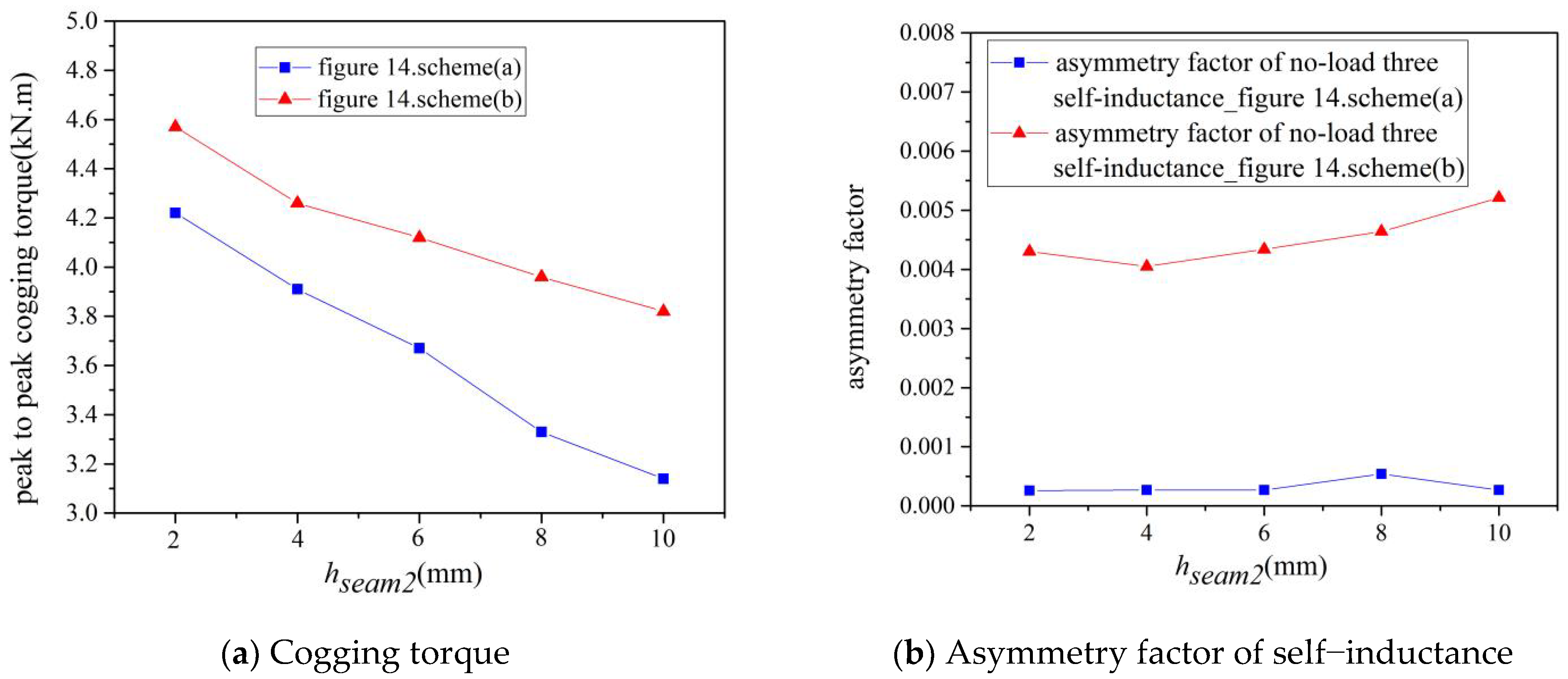
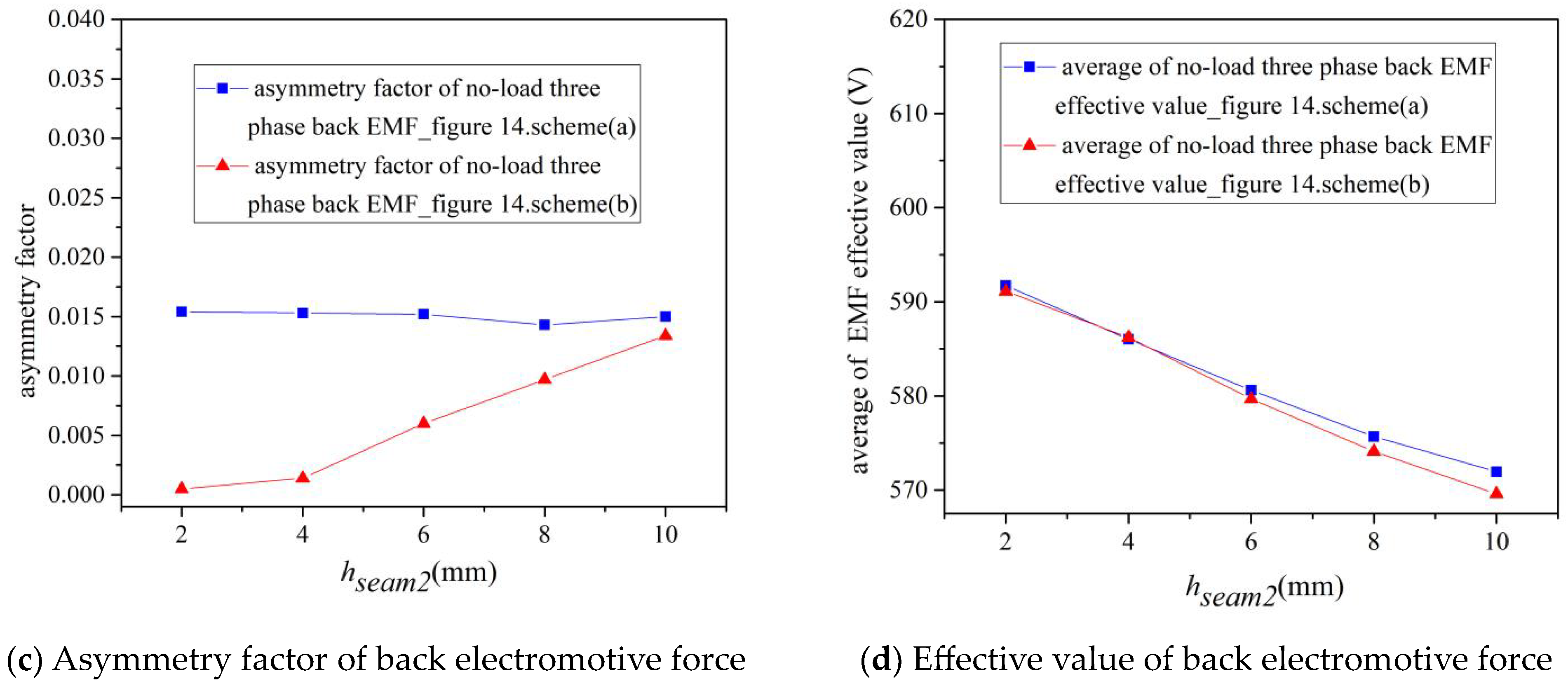

| Parameter | Values and Unit |
|---|---|
| Rated power of motor | 220 kW |
| Rated voltage | 660 V |
| Rated speed | 30 r/min |
| Rated frequency | 15 Hz |
| Number of rotor poles | 60 |
| Number of stator slots | 72 |
| Number of groups per pole per phase | 12 |
| Rotor structure | Out rotor with permanent magnet surface mounting |
| Outside diameter of rotor | 1270 mm |
| Thickness of rotor yoke | 50 mm |
| Core length | 1000 mm |
| Thickness of PM | 8 mm |
| Pole arc coefficient of PM | 0.83 |
| PM material | N42UH |
| Br at 20 °C | 1.3T |
| Hc at 20 °C | 971 kA/m |
| Relative magnet permeability | 1.06 |
| Air gap | 2.3 mm |
| Outside diameter of stator | 1149.4 mm |
| Slot height | 80 mm |
| Stator yoke height | 50 mm |
| Pitch | 1 |
| No-load back electromotive force | 609.5 V |
Disclaimer/Publisher’s Note: The statements, opinions and data contained in all publications are solely those of the individual author(s) and contributor(s) and not of MDPI and/or the editor(s). MDPI and/or the editor(s) disclaim responsibility for any injury to people or property resulting from any ideas, methods, instructions or products referred to in the content. |
© 2023 by the authors. Licensee MDPI, Basel, Switzerland. This article is an open access article distributed under the terms and conditions of the Creative Commons Attribution (CC BY) license (https://creativecommons.org/licenses/by/4.0/).
Share and Cite
Sun, S.; Feng, G.; Li, Y.; Zhang, B. Influence of Stator Core Seams on No-Load Performance of Module-Combined Stator Permanent Magnet Motor and Its Weakening Method. Energies 2023, 16, 4126. https://doi.org/10.3390/en16104126
Sun S, Feng G, Li Y, Zhang B. Influence of Stator Core Seams on No-Load Performance of Module-Combined Stator Permanent Magnet Motor and Its Weakening Method. Energies. 2023; 16(10):4126. https://doi.org/10.3390/en16104126
Chicago/Turabian StyleSun, Shaonan, Guihong Feng, Yan Li, and Bingyi Zhang. 2023. "Influence of Stator Core Seams on No-Load Performance of Module-Combined Stator Permanent Magnet Motor and Its Weakening Method" Energies 16, no. 10: 4126. https://doi.org/10.3390/en16104126
APA StyleSun, S., Feng, G., Li, Y., & Zhang, B. (2023). Influence of Stator Core Seams on No-Load Performance of Module-Combined Stator Permanent Magnet Motor and Its Weakening Method. Energies, 16(10), 4126. https://doi.org/10.3390/en16104126






